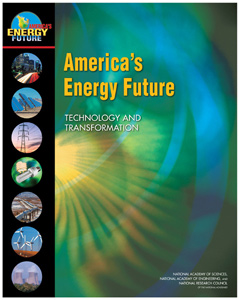America has the potential to solve its energy crisis over the next decade, but doing so will require immediate investment in clean energy technologies, says Mark S. Wrighton, chancellor of Washington University in St. Louis and vice chair of a National Resource Council (NRC) report on America’s energy challenges.
The report will be the topic of a symposium to be held from 12:30 to 5:30 p.m. Monday, Nov. 2, in the May Auditorium in Simon Hall on Washington University’s Danforth Campus.

Titled “America’s Energy Future: Technology and Transformation,” the capstone report summarizes findings from the America’s Energy Future project, an ongoing research effort sponsored by the National Research Council, the operating arm of the National Academy of Sciences and National Academy of Engineering.
The project’s committee of advisors, led by Harold T. Shapiro, president emeritus and professor of economics and public affairs at Princeton University, included more than two dozen leading academic and government science experts.
According to the report, what happens in the next decade will determine our energy future. “Actions taken — or not taken — between now and 2020 to develop and demonstrate several key technologies will largely determine the nation’s energy options for many decades to come,” the report says.
Wrighton will deliver the opening speech summarizing the report’s findings. “The United States needs abundant, affordable energy to assure sustained economic growth and development,” he said.
“Global growth in use of energy raises serious concerns regarding supply of energy. In addition, scientists have come to the consensus that the Earth’s future is threatened by the accumulation of atmospheric carbon dioxide (CO2) leading to global warming from use of fossil fuels including coal, oil, gasoline and natural gas. Adverse consequences of global warming are difficult to assess quantitatively, but the risk is so great that we must succeed in meeting this challenge.”
Other speakers will include energy experts who sat on the NRC committee that wrote the report, and the top officers of local energy companies that have a huge stake in the report’s recommendations.
In addition to Wrighton, NRC speakers will include Richard A. Meserve, president of the Carnegie Institution and former chairman of the U.S. Nuclear Regulatory Commission, and Maxine L. Savitz, vice president of the National Academy of Engineering and a member of the President’s Council of Advisors on Science and Technology.
Representatives of local energy industries will include Steven F. Leer, president and CEO of Arch Coal, and Dan Cole, senior vice president of Ameren Corp., as well as officers of Monsanto and Peabody Energy.
Charles K. Ebinger, director of the Energy Security Initiative at the Brookings Institution, will also speak. The Brookings Institution and WUSTL announced a new academic partnership in April of this year.
According to the report, existing energy-efficiency technologies offer the quickest and cheapest solutions to the energy crisis.
The potential energy savings available from accelerated deployment of existing energy-efficiency technologies in the buildings, industry and transportation sectors could more than offset projected increases in energy consumption through 2030, the report says.
For generating electricity, the NRC committee recommends a mix of coal and natural-gas plants with carbon capture and storage (CCS) and nuclear power plants. It suggests the construction of 15 to 20 retrofitted or new coal or natural gas plants with CCS before 2020 to demonstrate that carbon capture is practical and cost-effective.
Similarly, it suggests the construction of five nuclear power demonstration plants in the next decade.
The committee warns that “the urgency of getting started on these demonstrations to clarify future deployment options cannot be overstated.”
Modernizing the power grid is a third priority because it will allow the United States to tap intermittent energy sources such as wind and solar energy in the future.
The committee foresees little chance of replacing petroleum as a transportation fuel before 2020, although there are more promising longer-term options.
Achieving substantial reductions in greenhouse gas emissions from electrical power plants will require “a portfolio approach” that includes all of the improvements mentioned previously, as well as biomass with CCS and other types of renewable energy.
Extensive research and development by both public and private sectors will be necessary to meet these goals. Although the committee declines to pick technology winners and losers, it lists the following opportunities for demonstration projects in the next decade: carbon capture and storage, evolutionary nuclear technologies, cellulosic ethanol and advanced light-duty vehicles.
Research and development opportunities during the next decade include: advanced batteries and fuel cells, advanced large-scale storage of electrical load management, enhanced geothermal power, and enhanced solar photovoltaic technologies.
A strong advocate for research on clean energy technologies, Washington University recently invested more than $80 million to create a new International Center for Advanced Renewable Energy and Sustainability (I-CARES). Now in its third year, I-CARES encourages and coordinates university-wide and external collaborative research in the areas of renewable energy and sustainability — including biofuels, CO2 mitigation and coal-related issues.
Admission to the symposium, which is sponsored by I-CARES, is free, but reservations are required. Reservations can be made on the Web at https:aisweb.wustl.edu/Chancellor/symposium.nsf/rsvp?OpenForm, or starting at 11:30 a.m. on the day of the symposium at the meeting site.
For more information, contact Suzanne Loui at sloui@WUSTL.EDU or 314-935-8093.